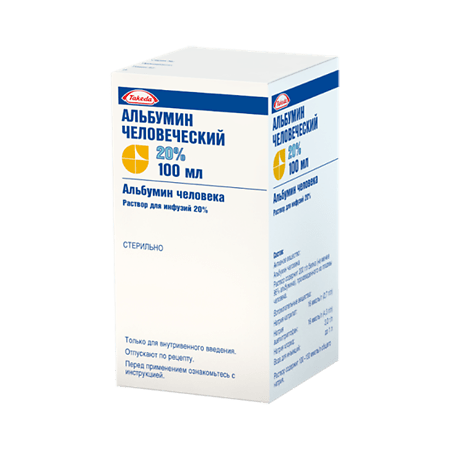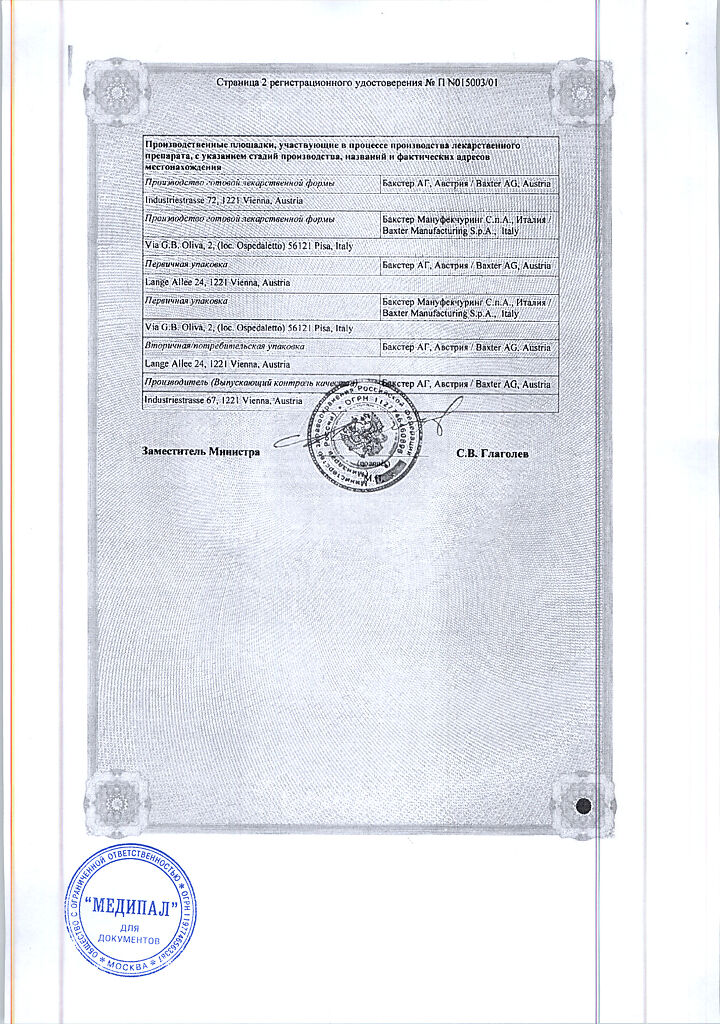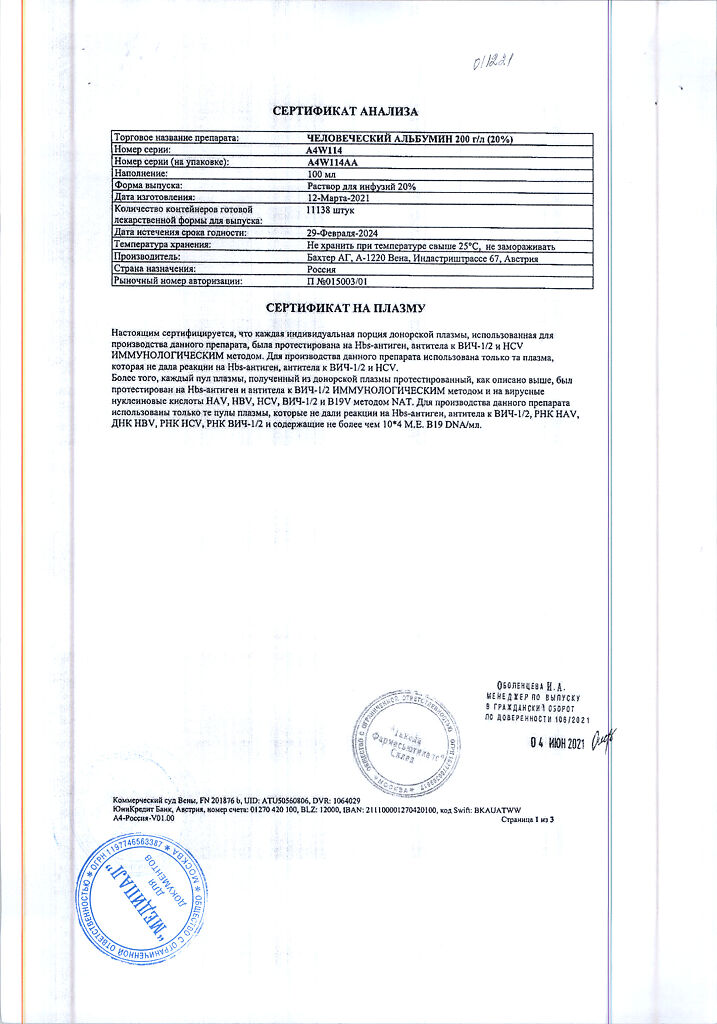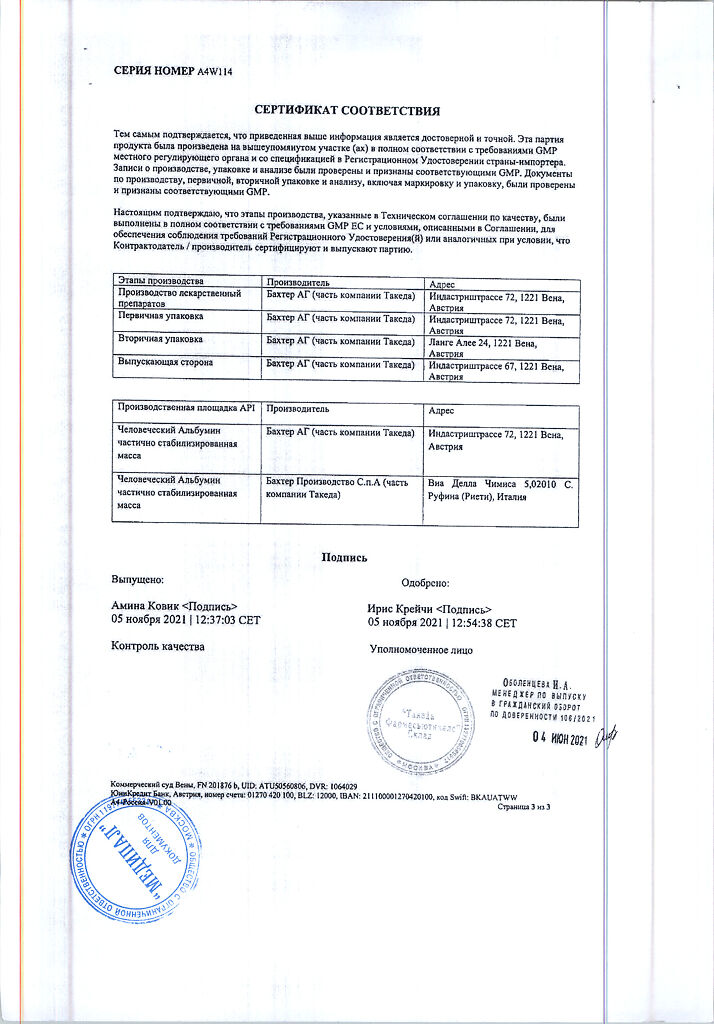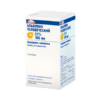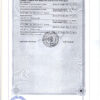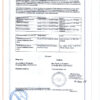No products in the cart.
Human albumin, 20% 100 ml
€135.27 €112.72
EAN: 4650081980355
SKU: 25034
Categories: Anesthesia and resuscitation, Anesthesia solutions, Medicine
Description
Pharmacotherapeutic group: plasma substitute
ATX code: Pharmacological Properties Pharmacodynamics Human albumin represents more than half of the total plasma protein; it accounts for about 10% of the protein-producing activity of the liver. Human albumin solutions of 200 g/L or 250 g/L have a hyperoncotic effect. The most important physiological functions of albumin are related to its contribution in regulating blood oncotic pressure and to its transport function. Albumin stabilizes circulating blood volume and transports hormones, enzymes, drugs and toxins. Pharmacokinetics .Normally, the total metabolic pool of albumin is 4-5 g/kg body weight, with 40-45% of albumin in the vascular stream and 55-60% in the extravascular space. In conditions such as severe burns or septic shock, capillary permeability increases, which alters the kinetics of albumin and, as a consequence, can lead to its abnormal distribution. Normally, the average albumin elimination half-life is about 19 days. The balance between albumin synthesis and cleavage is usually achieved through a feedback mechanism. The elimination process is predominantly intracellular through the action of lysosomal proteases. In healthy individuals, less than 10% of albumin administered by infusion is eliminated from the intravascular space within the first two hours. There is considerable individual variability in the effect of albumin on plasma volume. In some patients plasma volume may remain increased for several hours. However, in critical conditions, albumin may be eliminated from the vascular bed in significant amounts and at an unpredictable rate.
Indications
Indications
The drug Albumin human is recommended for restoring and maintaining circulating blood volume in case of insufficient volume and the advisability of using colloidal solutions.
The choice of the drug Human Albumin instead of synthetic colloidal solutions is determined by the clinical condition of the patient, as well as the standards of medical care.
The drug Albumin human can be used for the following clinical conditions:
shock – for emergency treatment in case of shock and other similar conditions when urgent restoration of circulating blood volume is required;
burns – to prevent severe hemoconcentration and maintain the required electrolyte balance (human Albumin in an isotonic solution (5% dextrose solution or 0.9% sodium chloride solution));
hypoproteinemia with or without edema – in clinical situations usually associated with low plasma protein concentrations and leading to a decrease in circulating blood volume;
hypoalbuminemia – when albumin deficiency is the result of insufficient synthesis, excessive catabolism, loss due to burns, injuries, or as a result of redistribution within the body.
Pharmacological effect
Pharmacological effect
Pharmacotherapeutic group: plasma replacement agent
ATC code: B05AA01
PHARMACOLOGICAL PROPERTIES
Pharmacodynamics
Human albumin represents more than half of the total plasma protein; it accounts for approximately 10% of the protein synthesizing activity of the liver.
Human albumin solution 200 g/l or 250 g/l has a hyperoncotic effect.
The most important physiological functions of albumin are related to its contribution to the regulation of blood oncotic pressure and its transport function. Albumin stabilizes circulating blood volume and transports hormones, enzymes, drugs and toxins.
Pharmacokinetics
Normally, the total metabolic pool of albumin is 4-5 g/kg body weight, with 40-45% of albumin located in the vascular bed, and 55-60% in the extravascular space. In conditions such as severe burns or septic shock, capillary permeability increases, which changes the kinetics of albumin and, as a consequence, can lead to its abnormal distribution. Normally, the average half-life of albumin is about 19 days. The balance between albumin synthesis and breakdown is usually achieved through a feedback mechanism. The elimination process occurs predominantly intracellularly under the action of lysosomal proteases.
In healthy individuals, less than 10% of infused albumin is eliminated from the intravascular space within the first two hours. There is significant interindividual variability in the effect of albumin on plasma volume. In some patients, the blood plasma volume may remain elevated for several hours. However, in critical conditions, albumin can be removed from the vascular bed in significant quantities and at an unpredictable rate.
Special instructions
Special instructions
IMPACT ON THE ABILITY TO DRIVE VEHICLES AND OPERATE MACHINERY
There are no data on the effect of human albumin on the ability to drive a car and perform work with other machines and mechanisms that require increased attention.
SPECIAL INSTRUCTIONS AND PRECAUTIONS FOR USE
Allergic reactions / anaphylactic shock
If an allergic or anaphylactic reaction is suspected, the drug should be stopped immediately and appropriate treatment should be initiated. In case of shock, anti-shock therapy should be started in accordance with current standards of treatment.
Hemodynamics
Human Albumin should be administered subject to careful monitoring of hemodynamic parameters for the development of symptoms of cardiac or respiratory failure, renal failure, or increased intracranial pressure.
Hypervolemia/hemodilution
The drug Albumin human should be used with caution in conditions where hypervolemia and its consequences or hemodilution may pose a particular risk to the patient, in particular with decompensated heart failure, arterial hypertension, esophageal varices, pulmonary edema, hemorrhagic diathesis, severe anemia, renal and postrenal anuria.
The colloidal osmotic effect of a human albumin solution at a concentration of 200 g/l is approximately four times higher than that of blood plasma. Therefore, when administering a concentrated albumin solution, the patient should be adequately hydrated. Careful monitoring is necessary to prevent cardiovascular overload and overhydration.
The rate of administration of the drug Albumin human should be selected taking into account the concentration of the infusion solution and hemodynamic parameters. If the infusion rate does not correspond to the patient’s condition, hypervolemia and pulmonary edema may develop. When the first clinical signs of overload of the cardiovascular system appear (headache, shortness of breath, swelling of the jugular veins), when blood pressure increases, central venous pressure increases, or when pulmonary edema develops, the infusion should be stopped immediately.
Large volumes
If it is necessary to replace relatively large volumes of fluid, it is necessary to monitor coagulation parameters and hematocrit. Adequate replacement of other blood components (clotting factors, electrolytes, platelets and red blood cells) should be ensured and hemodynamic parameters should be strictly monitored.
Before administering large volumes, the drug should be warmed to room temperature or body temperature.
Electrolyte status
When administering the drug Albumin human, it is necessary to monitor the patient’s electrolyte status (see section “Method of administration and dosage”) and take appropriate measures to restore and maintain electrolyte balance. The drug Albumin human contains sodium in the amount of 100-130 mmol/l, which must be taken into account when using it in patients on a low-salt diet.
Blood pressure
Elevated blood pressure following an infusion of Human Albumin requires close monitoring of the patient who has undergone trauma or surgery to identify damaged blood vessels that might not bleed at lower blood pressure and take appropriate action.
Infection prevention
Standard measures to prevent infections arising from the use of medicinal products derived from human plasma or blood include donor selection, screening of individual donations and plasma pools for specific markers of infection, and the use of effective virus inactivation/removal measures during the manufacturing process. Despite this, when administering medicinal products produced from human blood or plasma, the possibility of transmitting an infectious agent cannot be completely excluded. This also applies to unknown or new viruses and other pathogens.
There have been no reports of virus transmission from Human Albumin manufactured in accordance with European Pharmacopoeia specifications using standard processes.
Whenever Albumin Human is administered, it is strongly recommended that the trade name and lot number of the drug be recorded to understand the relationship between the patient and the specific product lot.
Pharmaceutical incompatibility
The drug Albumin human should not be mixed with other drugs (except for the recommended solvents indicated in the section “Method of administration and dosage”), whole blood and red blood cells. Human albumin should also not be mixed with protein hydrolysates, particularly parenteral nutrition solutions or solutions containing alcohol, as this may result in protein precipitation.
Use and disposal
If the solution becomes cloudy, the seal of the bottle is broken, or if a leak is detected, the drug should not be used. Before use, preparations for parenteral administration should be visually checked for the presence of mechanical inclusions and color changes, if the color of the solution and the material of the container allow this. The drug Albumin human does not contain preservatives, therefore the contents of the bottle should be used immediately after opening. Unused remainder of the drug should be destroyed in accordance with local requirements.
When using sterile water for injection to dilute Human Albumin at concentrations of 20% or higher, there is a potential risk of fatal hemolysis and acute renal failure. Suitable diluents are 5% dextrose solution or 0.9% sodium chloride solution.
Active ingredient
Active ingredient
Human albumin
Composition
Composition
Active ingredient:
Human albumin – solution contains 200 g/l total protein (at least 95% albumin) produced from human plasma.
Excipients:
Caprilic acid 16 mmol/l N-acetyltryptophan 16 mmol/l
Water for injections up to 1 l
Total content of sodium ions 100 – 130 mmol/l
The solution is hyperoncotic.
Pregnancy
Pregnancy
The safety of human albumin when used in pregnant women and breastfeeding women has not been studied in controlled clinical studies. However, clinical experience with human albumin, a natural component of human blood, suggests no harmful effects on pregnancy, the fetus, or the newborn.
The effect of human albumin on fertility has not been studied in controlled clinical trials.
Animal reproductive function studies have not been conducted using human albumin.
To assess the safety of a human albumin preparation in relation to reproductive function, embryonic or fetal development, pregnancy, as well as peri- and postnatal development, the results of experimental studies on animals are insufficient. Before prescribing, the doctor in each specific case must carefully assess the possible risks and benefits of using human albumin.
Contraindications
Contraindications
Hypersensitivity to human albumin or any other component of the drug.
WITH CAUTION
The drug Albumin human should be used with caution in conditions where hypervolemia and its consequences or hemodilution may pose a particular risk to the patient, in particular with decompensated heart failure, arterial hypertension, esophageal varices, pulmonary edema, hemorrhagic diathesis, severe anemia, renal and postrenal anuria.
Side Effects
Side Effects
Adverse effects observed during clinical trials
In controlled clinical trials of the drug Albumin human, sponsored by the company, there was no data on the development of adverse adverse reactions.
Adverse effects observed during post-registration use
During post-marketing use of Albumin Human, the following adverse reactions were observed, listed according to system organ classification (SOC) using the preferred Medical Dictionary of Regulatory Activities (MedDRA) terms in descending order of severity.
Immune system disorders: anaphylactic shock, anaphylactic reactions, hypersensitivity/allergic reactions
Nervous system disorders: headache, dysgeusia
Cardiovascular system disorders: myocardial infarction, atrial fibrillation, tachycardia, hypotension, hyperemia
Disorders of the respiratory system, chest and mediastinal organs: pulmonary edema, shortness of breath
Gastrointestinal tract disorders: vomiting, nausea
Skin and subcutaneous tissue disorders: urticaria, rash, itching
General disorders and reactions at the injection site: hyperthermia, chills
Safety information regarding vector-borne agents is provided in the section “Special instructions and precautions for use.”
Interaction
Interaction
Human albumin should not be mixed with other drugs (with the exception of isotonic solutions, for example, 5% dextrose solution or 0.9% sodium chloride solution), blood or red blood cells.
Specific interactions of human albumin with other drugs are unknown.
Overdose
Overdose
Human albumin should not be mixed with other drugs (with the exception of isotonic solutions, for example, 5% dextrose solution or 0.9% sodium chloride solution), blood or red blood cells.
Specific interactions of human albumin with other drugs are unknown.
Storage conditions
Storage conditions
Store at a temperature not exceeding 25 °C in the original packaging. Do not freeze.
Keep out of the reach of children.
Shelf life
Shelf life
3 years
Do not use after the expiration date stated on the package.
Manufacturer
Manufacturer
Baxter Pharmaceutical Solutions LLC, USA
Additional information
| Shelf life | 3 years Do not use after the expiration date stated on the package. |
|---|---|
| Conditions of storage | Store at a temperature not exceeding 25 °C in the original container. Do not freeze. Keep out of the reach of children. |
| Manufacturer | Baxter Pharmaceutical Solutions LLC, USA |
| Medication form | solution for infusion |
| Brand | Baxter Pharmaceutical Solutions LLC |
Related products
Buy Human albumin, 20% 100 ml with delivery to USA, UK, Europe and over 120 other countries.

